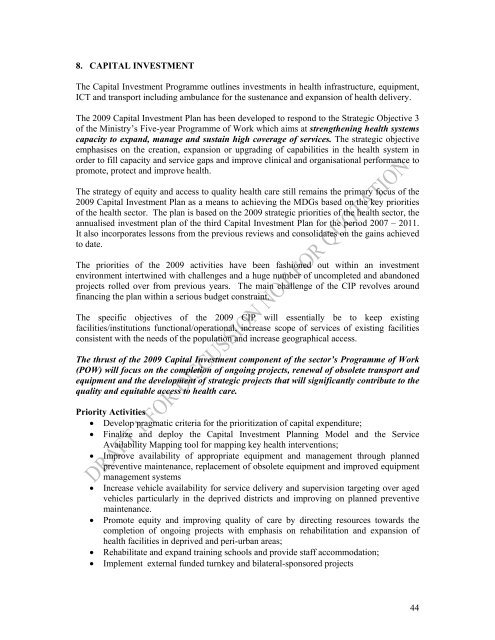Annual Programme of Work 2009 - Ministry of Health
Annual Programme of Work 2009 - Ministry of Health
Annual Programme of Work 2009 - Ministry of Health
Create successful ePaper yourself
Turn your PDF publications into a flip-book with our unique Google optimized e-Paper software.
8. CAPITAL INVESTMENT<br />
The Capital Investment <strong>Programme</strong> outlines investments in health infrastructure, equipment,<br />
ICT and transport including ambulance for the sustenance and expansion <strong>of</strong> health delivery.<br />
The <strong>2009</strong> Capital Investment Plan has been developed to respond to the Strategic Objective 3<br />
<strong>of</strong> the <strong>Ministry</strong>’s Five-year <strong>Programme</strong> <strong>of</strong> <strong>Work</strong> which aims at strengthening health systems<br />
capacity to expand, manage and sustain high coverage <strong>of</strong> services. The strategic objective<br />
emphasises on the creation, expansion or upgrading <strong>of</strong> capabilities in the health system in<br />
order to fill capacity and service gaps and improve clinical and organisational performance to<br />
promote, protect and improve health.<br />
The strategy <strong>of</strong> equity and access to quality health care still remains the primary focus <strong>of</strong> the<br />
<strong>2009</strong> Capital Investment Plan as a means to achieving the MDGs based on the key priorities<br />
<strong>of</strong> the health sector. The plan is based on the <strong>2009</strong> strategic priorities <strong>of</strong> the health sector, the<br />
annualised investment plan <strong>of</strong> the third Capital Investment Plan for the period 2007 – 2011.<br />
It also incorporates lessons from the previous reviews and consolidates on the gains achieved<br />
to date.<br />
The priorities <strong>of</strong> the <strong>2009</strong> activities have been fashioned out within an investment<br />
environment intertwined with challenges and a huge number <strong>of</strong> uncompleted and abandoned<br />
projects rolled over from previous years. The main challenge <strong>of</strong> the CIP revolves around<br />
financing the plan within a serious budget constraint.<br />
The specific objectives <strong>of</strong> the <strong>2009</strong> CIP will essentially be to keep existing<br />
facilities/institutions functional/operational, increase scope <strong>of</strong> services <strong>of</strong> existing facilities<br />
consistent with the needs <strong>of</strong> the population and increase geographical access.<br />
The thrust <strong>of</strong> the <strong>2009</strong> Capital Investment component <strong>of</strong> the sector’s <strong>Programme</strong> <strong>of</strong> <strong>Work</strong><br />
(POW) will focus on the completion <strong>of</strong> ongoing projects, renewal <strong>of</strong> obsolete transport and<br />
equipment and the development <strong>of</strong> strategic projects that will significantly contribute to the<br />
quality and equitable access to health care.<br />
Priority Activities<br />
• Develop pragmatic criteria for the prioritization <strong>of</strong> capital expenditure;<br />
• Finalize and deploy the Capital Investment Planning Model and the Service<br />
Availability Mapping tool for mapping key health interventions;<br />
• Improve availability <strong>of</strong> appropriate equipment and management through planned<br />
preventive maintenance, replacement <strong>of</strong> obsolete equipment and improved equipment<br />
management systems<br />
• Increase vehicle availability for service delivery and supervision targeting over aged<br />
vehicles particularly in the deprived districts and improving on planned preventive<br />
maintenance.<br />
• Promote equity and improving quality <strong>of</strong> care by directing resources towards the<br />
completion <strong>of</strong> ongoing projects with emphasis on rehabilitation and expansion <strong>of</strong><br />
health facilities in deprived and peri-urban areas;<br />
• Rehabilitate and expand training schools and provide staff accommodation;<br />
• Implement external funded turnkey and bilateral-sponsored projects<br />
44















